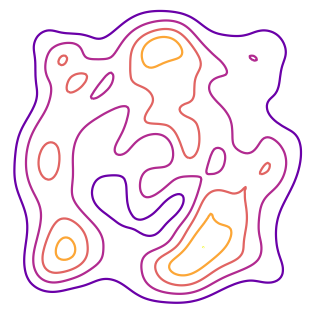aperture¶
- pyoof.aperture.aperture(x, y, I_coeff, K_coeff, d_z, wavel, illum_func, telgeo)[source]¶
Aperture distribution, \(\underline{E_\mathrm{a}}(x, y)\). Collection of individual distribution/functions: i.e. illumination function, \(E_\mathrm{a}(x, y)\), blockage distribution, \(B(x, y)\), aperture phase distribution, \(\varphi(x, y)\), and OPD function, \(\delta(x, y;d_z)\). In general, it is a complex quantity, its phase an amplitude are better understood separately. The FT (2-dim) of the aperture represents the (field) radiation pattern, \(F( u, v)\).
- Parameters
- x
Quantity Grid value for the \(x\) variable in length units.
- y
Quantity Grid value for the \(y\) variable in length units.
- I_coeff
list List which contains 4 parameters, the illumination amplitude, \(A_{E_\mathrm{a}}\), the illumination taper, \(c_\mathrm{dB}\) and the two coordinate offset, \((x_0, y_0)\). The illumination coefficients must be listed as follows,
I_coeff = [i_amp, c_dB, x0, y0].- K_coeff
ndarray Constants coefficients, \(K_{n\ell}\), for each of them there is only one Zernike circle polynomial, \(U^\ell_n(\varrho, \varphi)\).
- d_z
Quantity Radial offset, \(d_z\), added to the sub-reflector in length units. This characteristic measurement adds the classical interference pattern to the beam maps, normalized squared (field) radiation pattern, which is an out-of-focus property. It is usually of the order of centimeters.
- wavel
Quantity Wavelength, \(\lambda\), of the observation in length units.
- illum_func
function Illumination function, \(E_\mathrm{a}(x, y)\), to be evaluated with the key
I_coeff. The illumination functions available areillum_parabolicandillum_gauss.- telgeo
list List that contains the blockage distribution, optical path difference (OPD) function, and the primary radius (
float) in meters. The list must have the following order,telego = [block_dist, opd_func, pr].
- x
- Returns
- E
ndarray Grid value that contains general expression for aperture distribution, \(\underline{E_\mathrm{a}}(x, y)\).
- E
Notes
The aperture distribution is a collection of distributions/functions, its structure follows,
\[\underline{E_\mathrm{a}}(x, y) = B(x, y)\cdot E_\mathrm{a}(x, y) \cdot \mathrm{e}^{\mathrm{i} \{\varphi(x, y) + \frac{2\pi}{\lambda}\delta(x,y;d_z)\}}.\]Where it does represent a complex number, with phase: aperture phase distribution, plus OPD function and amplitude the blockage distribution and illumination function.
